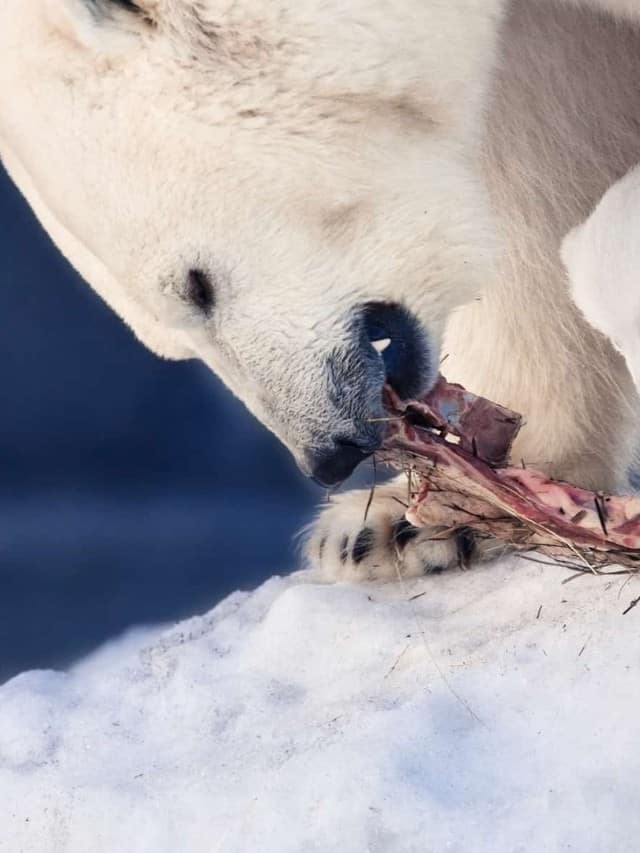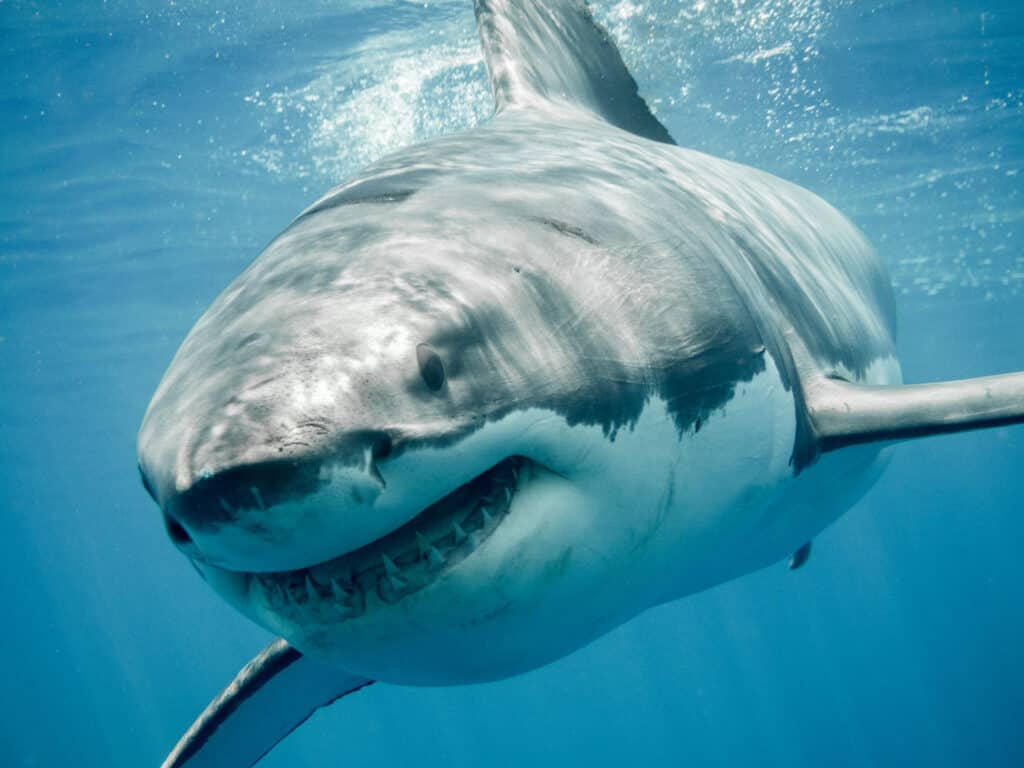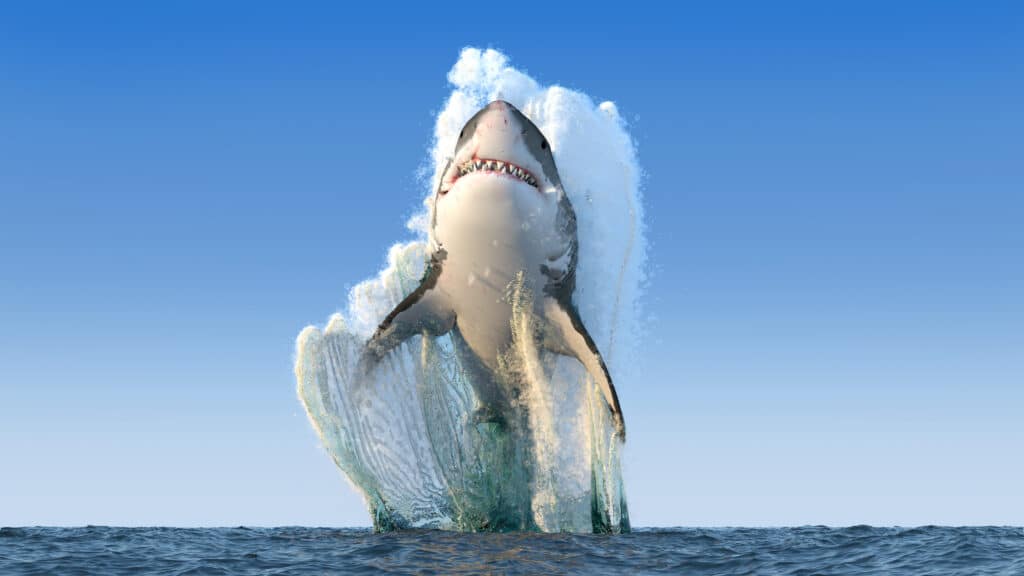Introduction
Polar bears and great white sharks are both apex predators with few natural predators in the wild. Furthermore, both animals are carnivores and hunt for similar prey, such as seals. While the two creatures share many similarities, they also have distinct differences that make them unique. In addition to their differences, one of these predators has much greater advantages in defense and attack than the other. Discover which animal would win in a fight and find out what dangers they pose to human life.
Background on Polar Bears
Polar bears are native to the Arctic region of the world, where temperatures are frigid, and fields of ice dominate the landscape. The polar bear ranks as one of the largest and strongest terrestrial carnivores, alongside other bear species like the brown bear or the Kodiak bear. The polar bear stays warm in the freezing Arctic because sunlight is absorbed by the bear’s black skin, which lies underneath the outer layer of fur. In addition, a layer of fat helps to insulate the polar bear from the cold.
Polar bears look much like other bear species with the primary difference being the creature’s white coat. Male polar bears may weigh between 900 and 1,600 pounds, and males are significantly larger than their female counterparts. The length of the polar bear ranges between 7.2 and 8.2 feet. In addition, the polar bear records an average height of approximately 5.3 feet on all fours, but on their hind legs, polar bears may measure nearly 10 feet tall.
Polar bears also have large feet, measuring around 12 inches in width, and their soles are covered in fur. The hair on the soles helps insulate the feet from the cold, especially since polar bears often travel across vast patches of ice. Furthermore, the soles are not smooth, giving the animal traction and allowing it to grip the ice and avoid slipping. Another feature that aids the polar bear in gripping the ice is its durable and sharp claws, which can puncture through ice and keep the animal grounded.

Polar bears are massive, weighing between 900 and 1,600 pounds with paws that stretch 12 inches wide.
©Vaclav Sebek/Shutterstock.com
Dangers of Polar Bears
The polar bear does not have natural predators in the wild, meaning that no animal threatens polar bear populations. Although, the polar bear is an apex predator and hunts many creatures. The diet of polar bears includes various seal species, such as ringed seals, harbor seals, and bearded seals. Polar bears may also attack and kill beluga whales. Finally, polar bears may also eat dead animal carcasses, especially those of beached whales.
Since the prey of the polar bear is comprised of aquatic species, polar bears must swim. While some may believe that the large, heavy mammal is not equipped to swim, this is false. Polar bears can swim at a rate of six miles per hour, and they are considered good swimmers. On land, the polar bear is not burdened by its weight and size either. The creature can run at speeds up to 25 miles per hour.
When polar bears hunt seals, they will stalk a seal while it rests near or on ice. Then, the polar bear attacks swiftly and may search for young seals, too. The two-inch teeth of the polar bear give it a strong bite that can rip apart flesh with ease. Furthermore, 42 teeth sit in the mouth of this carnivore. Thus, polar bears have an extremely strong bite, measuring greater than 1,200 PSI.
Polar bears typically hunt near fractured portions of ice. Fractured ice creates breathing holes for seals to utilize, as seals are marine mammals that must extend above the water’s surface to receive air. When a polar bear discovers fractured ice pockets, it may wait to see if any seals are nearby. If seals do appear, the polar bear attacks them.
Finally, polar bears are not afraid of human encounters. In fact, many attacks on humans by polar bears have been recorded. The predator may attack humans as well as their property. As polar bears continue to suffer from habitat loss due to climate change and move closer to human life, attacks on humans increase. An estimated 20 fatal ambushes on humans by polar bears have occurred. Therefore, the polar bear is a highly dangerous animal and should be avoided by humans.

The polar bear has no natural predators in the wild.
©Shvaygert Ekaterina/Shutterstock.com
Background on Great White Sharks
Like the polar bear, the great white shark is an apex predator. However, the shark has one natural predator: the killer whale. Great white sharks are some of the most dangerous creatures in the world, feared by many marine animals and by humans, too. The distribution of this predator covers much of Earth’s oceans and seas, ranging from the United States to Chile and from Japan to Australia. Furthermore, great whites prefer to swim close to the coast. While they may venture into the open ocean, they return to coastal waters to hunt for prey.
Great whites may grow up to 21 feet long, and they weigh between 1,500 and 4,000 pounds. Although, some individuals in this species have exceeded 5,000 pounds! Great white sharks usually appear gray, blue, or brown, and they have a white underbelly. The white underbelly of the shark inspired the usage of “white” in its name. These fish are extremely muscular and strong, two features that allow them to hunt and kill prey with ease.

Great white sharks have a wide distribution, and they usually swim in coastal waters.
©Ramon Carretero/Shutterstock.com
Dangers of Great White Sharks
Like polar bears, great white sharks enjoy hunting and killing seals as prey. In addition, the great white may attack large animals, such as whales, and they have few limits to what they will kill and consume. One feature of the great white that aids it in catching prey is its sense of smell. The shark has an incredible sense of smell due to an organ called the olfactory bulb, located beneath its snout. The olfactory bulb of the great white can detect one part of a substance per 10 billion parts of water. In other words, the great white’s sense of smell is especially strong, allowing it to detect prey quickly.
Another feature useful to the great white’s hunt of prey is its many teeth. The shark has around 300 serrated teeth in its mouth. These teeth are arranged in several rows, and they are extremely sharp. In fact, great white shark teeth can slice open flesh and destroy bones. The jaws of this species are powerful, too. The great white shark records a bite force of 4,000 PSI. The shark’s bite force is the second strongest in the world, behind the Nile crocodile, which places first with a bite force measuring 5,000 PSI.
Great whites are also dangerous to human life. In most cases, great white sharks do not intentionally hurt humans. Rather, a human swimming or surfing on the ocean’s surface may look like a seal to a great white shark below. Thus, the great white may attack a human, but often retreats after it realizes its mistake. The only instances in which a great white shark attacks humans intentionally are if the creature feels threatened or is provoked by humans.

The sharp, serrated teeth of the great white can rip apart the flesh of any animal.
©Martin Prochazkacz/Shutterstock.com
Polar Bear vs. Great White Shark: A Comparison
| Characteristics | Polar Bear | Great White Shark |
|---|---|---|
| Size | 7.2 to 8.2 feet (length) 5.3 feet (height) | 21 feet (length) |
| Weight | 900 to 1,600 pounds | 1,500 to 4,000 pounds |
| Aggression | Highly aggressive | Highly aggressive |
| Dangers | Bite, strength, speed, sharp claws, and attacks large animals and humans | Bite, strength, sharp teeth, and attacks large animals and humans |
| Bite Force | 1,200 PSI | 4,000 PSI |
| Color | White | Gray, blue, and brown |
| Teeth | 42 teeth at two inches in length | 300 serrated teeth arranged into rows |
Which Animal Would Win in a Fight: Polar Bear or Great White Shark?
In an epic battle between a polar bear and a great white shark, the great white shark would emerge victorious. While the polar bear is extremely dangerous and has no natural predators, it cannot compete with the great white shark in size or strength. The largest polar bears usually weigh 1,600 pounds, but the largest great whites weigh over 5,000 pounds, meaning the great white maintains a considerable size advantage.
Furthermore, great white sharks record greater lengths than polar bears, measuring more than twice the size of polar bears. The great white also has a significantly stronger bite force. While the polar bear has a bite force of around 1,200 PSI, the bite force of the great white shark measures 4,000 PSI. Thus, the jaws of the great white are stronger than those of the polar bear. Jaw strength and the hundreds of sharp teeth of the great white make for a practically unbeatable combination in a fight. The shark could overpower the polar bear in this battle, making the great white the winner.

The huge and terrifying great white shark would win in a fight against a polar bear due to its advantages in size, strength, and bite force.
©Alexyz3d/Shutterstock.com
Thank you for reading! Have some feedback for us? Contact the AZ Animals editorial team.








